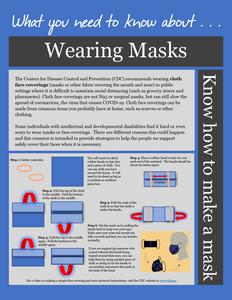Know how to make a mask
Wearing Masks
The Centers for Disease Control and Prevention (CDC) recommends wearing cloth face coverings (masks or other fabric covering the mouth and nose) in public settings where it is difficult to maintain social distancing (such as grocery stores and pharmacies). Cloth face coverings are not N95 or surgical masks, but can still slow the spread of coronavirus, the virus that causes COVID-19. Cloth face coverings can be made from common items you probably have at home, such as scarves or other clothing.
Some individuals with intellectual and developmental disabilities find it hard or even scary to wear masks or face coverings. There are different reasons this could happen and this resource is intended to provide strategies to help the people we support safely cover their faces when it is necessary.
Understand why masks can be hard to wear
When people have trouble wearing masks, one or more of these reasons might be causing that feeling.
Masks can be
. Having fabric placed over your mouth and nose can be
a scary experience for individuals, especially if they do not understand why it is
necessary. Masks can be even more scary for people who already have trouble
breathing.
Masks can be
. Some individuals have trouble tolerating
different textures of fabric and/or fabric and bands around their face.
Masks can be
. Some individuals might think masks make
them look different from the people around them, especially when supporters
are not wearing masks.
Understand how you can help
Here are some things we can do to help the individuals we support to wear masks.
Making masks less scary Explain why we need to wear masks. Use a social story to help explain masks to individuals with more limited communication. Start with wearing masks for short times, such as 5 or 10 minutes using a timer or long enough to walk outside and get the mail. Make sure an individual's mask is not obstructing their breathing. If it is, adjust the mask or use a different type of facial covering, such as a scarf or wrap. Work on this together. All supporters should be wearing masks along with the individual. Set expectations and rehearse. If masks are needed for an appointment, explain when the mask will be put on and when it will come off. Role playing may be helpful.
Making masks more comfortable Use fabric or string to connect the rubber bands and tie the mask behind the individual's head to avoid looping over ears. Make sure the mask is not rubbing skin in a way that causes redness. Check for redness each time you take the mask off and take precautions to prevent any breakdown. Consider an alternative, such as a scarf or wrap that can be pulled over the individual's mouth and nose. Avoid touching the individual lightly when applying a mask. Use a firm but gentle touch. If the individual has an occupational therapist, consult with the therapist for strategies.
Making masks seem less stigmatizing Explain why we need to wear masks. Consider educational videos that show other people wearing masks. Supporters should wear masks whenever required to do so.
Georgia Department of Behavioral Health and Developmental Disabilities
This Masks Fact Sheet is #9 in a series of Improving Health Outcomes Fact Sheets. It was developed in collaboration with the Integrated Clinical Support Team and with reference to resources available through US Centers for Disease Control and Prevention and the Georgia Department of Public Health. This Fact Sheet is not a substitute for clinical evaluation or physician's orders. The information above is current as of April 9, 2020.
